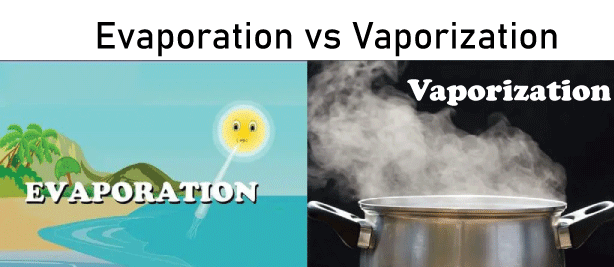Difference Between Evaporation and Vaporization

Evaporation and vaporization are both processes involving the conversion of liquid into vapor, but they differ in terms of their mechanisms, conditions, and scales. Here are the key differences between evaporation and vaporization:
-
Definition:
- Evaporation: Evaporation is the process by which a liquid changes into vapor at temperatures below its boiling point. It occurs only at the surface of the liquid.
- Vaporization: Vaporization is the general process by which a substance changes from a liquid or solid state into a vapor (gas) state. It encompasses both evaporation and boiling, occurring throughout the entire volume of the liquid.
-
Temperature:
- Evaporation: Evaporation occurs at temperatures below the boiling point of the liquid. It can happen at any temperature, but it is more rapid at higher temperatures.
- Vaporization: Vaporization includes both evaporation and boiling and can occur at or above the boiling point of the liquid.
-
Surface Area:
- Evaporation: Evaporation takes place only at the surface of the liquid, where molecules with sufficient kinetic energy escape into the vapor phase.
- Vaporization: Vaporization involves the conversion of liquid into vapor throughout the entire volume of the liquid, not just at the surface.
-
Rate:
- Evaporation: The rate of evaporation is generally slower compared to vaporization because it occurs only at the liquid's surface.
- Vaporization: Vaporization can occur rapidly, especially during boiling, as it involves the conversion of liquid into vapor throughout the entire volume of the liquid.
-
Energy Requirement:
- Evaporation: Evaporation is an endothermic process that requires energy input to overcome intermolecular forces and convert liquid molecules into vapor. This energy is typically provided by heat from the surroundings.
- Vaporization: Vaporization is also an endothermic process but requires more energy compared to evaporation, especially during boiling, where the entire liquid volume undergoes phase transition.
-
Examples:
- Evaporation: Examples of evaporation include the drying of wet clothes, the evaporation of water from the surface of lakes and oceans, and the drying of puddles after rain.
- Vaporization: Examples of vaporization include boiling water in a kettle, sublimation of dry ice (solid carbon dioxide) into gas, and the vaporization of liquid nitrogen into nitrogen gas.
In summary, evaporation is a specific type of vaporization that occurs at the surface of a liquid below its boiling point, while vaporization encompasses the broader process of converting a substance from a liquid or solid state into vapor, occurring throughout the entire volume of the substance.
Thank you,
